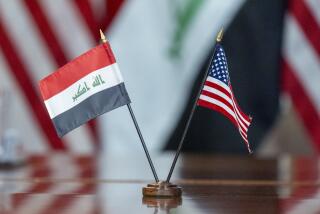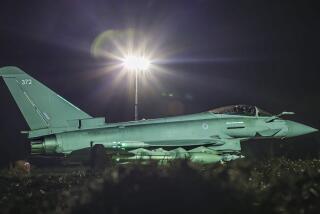Suicide Blast at Base in Iraq Kills 1
- Share via
RAMADI, Iraq — In a major breach of security, a suicide attacker infiltrated a heavily guarded U.S. military base and set off a powerful car bomb Thursday, killing one U.S. soldier and wounding 14 others, military officials said.
It was the third suicide assault on a U.S. base in Iraq this week, but the only successful infiltration -- and the first in which a U.S. soldier was killed.
The explosion, which sent a huge fireball into the air and was heard miles away, occurred inside the sprawling compound of Task Force All American in a former palace complex of Saddam Hussein, west of Baghdad along the Euphrates River. The military offered few details about how the bomb was brought onto a secure base. It hadn’t yet identified the soldier.
“Initially we thought it might be a truck bomb at the back gate,” said Army Capt. Jeff Fitzgibbons. “Once we came out, we realized it wasn’t at the back gate. It was inside.”
After the explosion at about 1:30 p.m., stunned soldiers sprinted from their barracks and posts and rushed to assist the wounded and repel any further attack on the base, known as Champion Main. Reinforcements were rushed in to guard the compound, which is home to about 800 soldiers, including Maj. Gen. Charles H. Swannack Jr., who commands the Army’s 82nd Airborne Division.
Of the 14 wounded, three suffered severe injuries, an official said. The rest were treated and returned to duty.
The incident was expected to force a reassessment of protective measures at the Army’s fortified bases throughout Iraq, which are also accessible to thousands of Iraqi civilians, many of whom arrive in cars and trucks.
“Is this a breach in security? Absolutely,” Fitzgibbons said. “Our goal is obviously to minimize U.S. casualties and ensure that our forces are protected.”
All nonmilitary vehicles and visitors are searched before entering U.S. bases, but officials acknowledge that the procedure may sometimes be less than thorough. Dozens of trucks routinely line up outside the gates of some U.S. facilities waiting to deliver construction materials, food and other supplies. Searching each vehicle can take hours.
“The bottom line is, these guys were clever in terms of preparing their vehicle,” said one military official in Baghdad who asked not to be named. “So what we’re going to have to do is be more scrupulous in terms of examining the vehicles that come through the gate.”
The official said it was his understanding that more than one suicide attacker was in the vehicle, but there was no official confirmation of how many participated. Some reports said as many as three people might have been in the car.
Although bases are vulnerable to mortar and rocket attacks, such weapons are notoriously errant in Iraq. Suicide bombings, by contrast, can be as accurate as guided missiles, experts said.
Most U.S. bases are set up away from population centers and are typically encircled by reinforced walls, concertina wire and sandbags. Troops are stationed at the front gate and in machine gun nests, and obstacle courses are in place to prevent vehicles from ramming into the compounds. Sentries in guard towers enable quick reaction to pedestrians or vehicles that fail to heed signs instructing them to halt for checks.
Outside the targeted base on Thursday, dozens of jittery soldiers kept a tight guard at the two main gates and along a nearby bridge over the Euphrates. The troops diverted traffic and were on their guard for another possible assault from a passing vehicle.
“There’s a lot of Iraqis coming into the bases, and we can’t control every one of them,” one officer observed. “It’s not a good situation.”
Several Iraqi civilians who work at the base said they were interrogated intensively by U.S. officials after the bombing.
“They wanted to know who we worked for, what we were doing, how long we were there,” said Ahmed Hamid, 17, a laborer who spoke to a reporter outside the base after completing his shift and being allowed to go home with several other young workers. “They were very upset.”
He and a co-worker said they were questioned about a blue Kia pickup truck. Authorities would not confirm that such a vehicle was suspected in the blast.
The attackers’ aim seems to be to inflict catastrophic losses on U.S. forces, perhaps akin to the 1983 truck bombing in Beirut that killed 241 Americans, mostly Marines. Soon after, President Reagan decided to withdraw troops from Lebanon.
Task Force All American is composed primarily of members of the 82nd Airborne Division, which patrols much of the so-called Sunni Triangle, the swath of central and western Iraq that is the focal point of the insurgency against the U.S.-led occupation.
Ramadi has long been the site of attacks against U.S. forces and their allies -- mortar shelling of the base here was an almost-daily event for a stretch during the summer. In July, a bomb killed seven Iraqi police recruits, probably targeted because they worked with the U.S.
But Swannack said recently that the city has calmed and that he was considering turning all patrols over to Iraqi security forces and largely withdrawing from city limits. Whether Thursday’s attack will change that possibility was unknown.
Besides broken windows, the most serious damage was done to a military Humvee and a trailer, both within 40 feet of the blast site, Fitzgibbons said. It was unclear whether the attacking vehicle was moving when the bomb went off or how far into the base the car had advanced. The explosion site was about 500 feet from the base’s Tactical Operations Center, the operational hub, Fitzgibbons said. Elsewhere in Iraq, another U.S. fatality was reported. A soldier with the 1st Armored Division drowned, apparently accidentally, during a routine nighttime patrol along the Tigris River in Baghdad. At least 450 U.S. soldiers have died since the war began March 20.
*
McDonnell reported from Ramadi and Williams from Baghdad.
More to Read
Sign up for Essential California
The most important California stories and recommendations in your inbox every morning.
You may occasionally receive promotional content from the Los Angeles Times.











